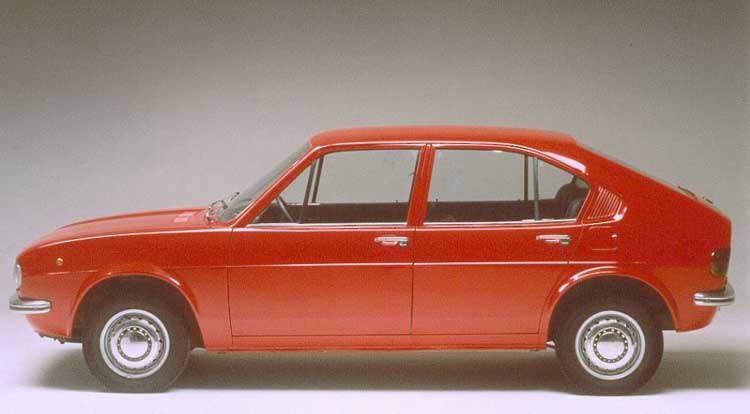Alfasud
It was cheap, ill-bred - and drivers couldn't get enough, says Brian Sewell

Few mass-produced cars of the 1970s are remembered with respect - indeed, the most preposterous of them, the Austin Allegro, has become the butt of comedy, a symbol of the industry's nadir. The most notable exception to this decade of contemptible machines is Alfa Romeo's Alfasud - its Plain Jane looks redeemed by quirky engineering and design that made it "a driver's car'' to be hustled over mountains and across the continent as though it were a well-bred roadster of twice the engine size.
Few mass-produced cars of the 1970s are remembered with respect - indeed, the most preposterous of them, the Austin Allegro, has become the butt of comedy, a symbol of the industry's nadir. The most notable exception to this decade of contemptible machines is Alfa Romeo's Alfasud - its Plain Jane looks redeemed by quirky engineering and design that made it "a driver's car'' to be hustled over mountains and across the continent as though it were a well-bred roadster of twice the engine size.
In one sense, it is indeed well-bred, for the pedigree of all Alfa Romeos reaches back to 1915 when Nicola Romeo, racing enthusiast and great engineer, took over the ailing Alfa factory and employed the brilliant Vittorio Jano to design sports cars that to this day inspire awe; moreover, it was in running Alfa Romeo's racing department that Enzo Ferrari learned his trade.
But in another sense, it has no breeding at all, for it was the consequence of social engineering by a government that sought to introduce industry to the impoverished south of Italy. It built a factory in which indolent Neapolitan peasants found employment, producing a family car that was unreliable and badly made in materials of wretched quality.
The Alfasud was the tea-break and the pee-break car; the siesta and fiesta car to far outdo the Monday and the Friday cars notorious in America. It rusted before it left the factory - paint camouflaged this in the showrooms, but once on the street, rot ate the wings and sills, nibbled the floorpan and the jacking points, consumed the boot floor, loosened everything from hinge to shock absorber, and pocked the doors and bonnet.
If any car should have accelerated the then-declining fortune of the firm, it was the Alfasud. Instead, it brought Alfa Romeo engineering and performance within reach of a wider ownership at a cost that undercut the Allegro, and taught a bargain-hunting public the joys of driving fast and accurately, leaving many a young man determined to buy a bigger, better Alfa when he grew old and rich - hence the success of the current 164.
The balance, grip, cornering and utterly predictable behaviour, even in extremis, set a standard that is still outstanding, for it was the Peugeot 205 or Renault-Williams of its day.
The engine was designed by Rudolf Hruska - its four cylinders horizontally opposed, lying flat and low within the overhanging nose and driving the front wheels.
In its first incarnation, way back in 1971, it was of only 1,186cc, but the superb chassis demanded greater power, and in 13 years it grew to 1,286, 1,351 and 1,490cc, and from 63 to 95bhp. Purists may prefer the earliest and highest-revving engine, but the most refined and torquey is the 1,490cc version of 1978-84, mated to a close-ratio, five-speed gearbox that in top gives only 17.8mph at 1,000rpm - the scream of a performance gear, not a leisurely overdrive.
The Alfasud was at its best from 1980 until production ceased in 1984 - the rust problem much reduced; the plastic interiors replaced by black fabric; acceleration and top speed improved by the larger engine without worsening the fuel consumption.
The man who bought this because it was the same size as an Austin Allegro, but cheaper, found himself in charge of a car that responded instantly to a twitch of the wheel, rounding every bend with confident accuracy and no hint of over- or understeer, the accelerator and the brake perfectly placed for the toe of the racing driver.
On paper, its performance is much the same as the Allegro's, but on the road, it is as sure-footed as a cat and capable of covering great distances in a day for any driver who can tolerate the rorty exhaust note typical of Alfas. It turned many a middle-aged suburban driver into Mr Toad, and scared the wits out of his wife.
The owner of a good example might pretend to exclusivity, and certainly deserves respect for his taste in engineering. Those tempted to enquire should beware of sloppy suspension struts, worn synchromesh (this is a gearbox much over-used for the mindless pleasure of keeping up the revs), sagging doors on two-door models, Ti versions with the erratic twin-choke carburettor, and the ubiquitous rust.
The engine is intended to run at revs unknown to the Allegro, and has proved reliable over very high mileages - properly serviced, it will outlast all other components and the body.
But do not be seduced by a rusting bargain, for once set in, the decay's advance is as inexorable as the waves of the North Sea that lapped at Canute's feet, and only replacement of the floorpan, doors, bonnet and roof, and then all the bits and bobs demanded by perfection's lust, will put an end to it.
Subscribe to Independent Premium to bookmark this article
Want to bookmark your favourite articles and stories to read or reference later? Start your Independent Premium subscription today.

Join our commenting forum
Join thought-provoking conversations, follow other Independent readers and see their replies